| Revisiting the Hotspots: a New Book and an Updated Website |
|

|
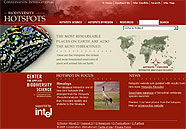
The Biodiversity Hotspots website was recently updated with results from the new book Hotspots Revisited.
|
|
In early February 2005, CI released the results of its latest analysis of the Biodiversity Hotspots in the form of a new book, Hotspots Revisited, and a revamped website. The 380-page book includes the work and original photography of more than 200 experts and, for the first time, provides a summary of freshwater fishes for each hotspot. The updated website, which offers a synthesis of all Hotspots as well as a new ‘Hotspots Science' section, also features an online database of terrestrial vertebrates that allows users to search for species occurring in or endemic to the hotspots.
Visit the revamped Biodiversity Hotspots website |
The study added nine new hotspots, including Japan and the East Melanesian Islands, for a total of 34 priority regions. The remaining habitat in these hotspots covers only 2.3 percent of earth's land area, and yet an incredible 50 percent of vascular plants and 44 percent of terrestrial vertebrates are found nowhere else. Hotspots are designated based on both their exceptionally high biodiversity and threats to remaining habitats and species. Consequently, they are also home to large numbers of threatened species; three-quarters of all Critically Endangered and Endangered mammals, birds, and amphibians are found only in the hotspots.
Some hotspots, like Sundaland and the Philippines, continue to face considerable degradation, largely due to extensive logging and agricultural expansion. Other regions, like Madagascar and the Indian Ocean Islands, have faired better; the future looks bright for conservation in Madagascar, given President Marc Ravalomanana's commitment to increase his nation's protected areas coverage by threefold. This is particularly encouraging given that recent research on higher-level endemism in the hotspots found that a total of 24 plant and vertebrate families are found no where else, once again highlighting the importance of Madagascar as among the top priorities for conservation efforts.
According to Peter Seligman, CEO of Conservation International, this reassessment of the world's conservation priorities, which began four years ago and drew from the work of almost 400 specialists, “ensures that CI will continue to direct conservation funds to the areas where we can have the greatest possible impact.”
| Sanctuary Declared for Dragonflies and Damselflies in the Hotspots of Brazil |
Top |
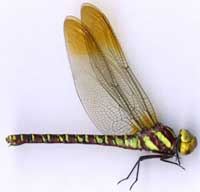
The Libelulas da Serra de São José State Wildlife Refuge in Brazil protects species of dragonflies and damselflies, such as Castoraeshna januaria pictured above. Image by Lúcio Bede.
|
 The eight-kilometer stretch of the pictorial Serra de São José (Minas Gerais State) in southeastern Brazil, was recently declared the Libelulas da Serra de São José State Wildlife Refuge for the protection of dragonflies and damselflies (Odonata). The region is a famous tourist destination for the scenic beauty of the sierra and, at its foot, the colonial town of Tiradentes. The eight-kilometer stretch of the pictorial Serra de São José (Minas Gerais State) in southeastern Brazil, was recently declared the Libelulas da Serra de São José State Wildlife Refuge for the protection of dragonflies and damselflies (Odonata). The region is a famous tourist destination for the scenic beauty of the sierra and, at its foot, the colonial town of Tiradentes.
This small mountain range lies in the contact zone of two hotspots - the Atlantic Forest to the south and the Cerrado to the north - and forms the southern tip of the Espinhaço, a majestic mountain chain that spans over 1000 kilometers of central Brazil. The varied landscape of the Serra de São José includes the largest Atlantic forest remnant in the region and numerous montane creeks and ponds. It is home to an exceptionally rich Odonata fauna; so far, 76 dragonfly species and 44 damselfly species have been recorded and more discoveries are predicted as assessments are undertaken throughout its 3,717 hectares.
Learn more about the Atlantic Forest and Cerrado Hotspots |
The Libelulas da Serra de São José wildlife refuge is the first of its kind in Brazil, and one of a few in the world with a primary focus on invertebrate conservation. As juveniles, dragonflies and damselflies are found underwater, in freshwater creeks and ponds, and are highly sensitive to water pollution. They spend their brief adult lives in nearby forests and meadows, returning to aquatic areas to reproduce. Thus, dragonflies and damselflies are natural flagship species for raising public awareness of the importance of conserving forests, aquatic habitats and biodiversity. The initiative to create this refuge was led by the local NGO Instituto Terra Brasilis, in partnership with CI-Brazil .
| Taxonomic Studies Change Conservation Priorities in the Caribbean Islands |
Top |
To many people, taxonomy – the classification of organisms in an ordered system to indicate natural relationships – appears dry and irrelevant. However, recent taxonomic work in the Caribbean is providing fascinating revelations that will markedly change conservation priorities.
A paper late last year by William Hayes and collaborators in the Bahamas Journal of Science suggests that the country's lone brown-headed nuthatch (Sitta pusilla) population, on Grand Bahama, should be recognized instead as a full, endemic species; the Bahama nuthatch (Sitta insularis). The study, supported by the Grand Bahama Power Company, distinguishes the new species on the basis of its longer bill, shorter wings, and distinctive vocalizations, and suggest that this imperiled bird should become a flagship for conservation efforts in the Bahamas. |
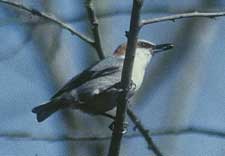
New research suggests that the brown-headed nuthatch (Sitta pusilla) should be recognized as a full species, endemic to Grand Bahama. Photo by Giff Beaton.
|
With a total of four surviving endemic bird species in the Bahamas, taxonomic revisions underway for a number of other birds, such as the West Indian woodpecker (Melanerpes superciliaris), could increase the global significance of conservation efforts in the country.
Conversely, a recent paper by Kristofer Helgen and Don Wilson in the Journal of the Zoological Society of London finally revealed that the Bahamian raccoon (Procyon maynardi) is, along with several other raccoon populations in the West Indies, actually only a relatively recent human-assisted invader of the country. Rather than being a number of distinct endemic species, these raccoons are actually a single species, the common northern raccoon (Procyon lotor), found throughout the nearby United States. Although the West Indian raccoons' conservation action plans acknowledge uncertainty over their taxonomic status, they are still listed as globally threatened by the IUCN Red List (a time lag that will be addressed by the Global Mammal Assessment). Indeed, in the light of this new knowledge, West Indian countries should now be urging the eradication rather than the conservation of these raccoons, since they are alien predators that threaten native species.
Both of these studies underscore, in contrasting ways, the critical importance of taxonomic research in guiding conservation action. In addition, they highlight the need for flexibility in conservation efforts to accommodate new taxonomic knowledge, and the need to find ways of explaining such dramatically changing conservation priorities to those outside the scientific community.
Learn more about the Caribbean Islands Hotspot
| Global Species Assessment Reveals over 15,000 species Face Extinction |
Top |
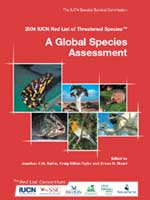
The Global Species Assessment and 2004 IUCN Red List was launched in November 2004
|
 A total of 15,589 species face extinction, according to the 2004 IUCN Red List of Threatened Species , which was recently released at the IUCN World Conservation Congress (Bangkok, Thailand, November 2004). The IUCN, through its Species Survival Commission, is the world's authority on assessing the conservation status of species, with four decades of experience highlighting and promoting the conservation of taxa threatened with extinction. The 2004 IUCN Red List is accompanied by the Global Species Assessment (GSA), the most comprehensive evaluation ever undertaken of the status of the world's biodiversity; it provides an analysis of Red List data, and provides additional context. The GSA is produced by the Red List Consortium comprising IUCN and its Species Survival Commission , Conservation International and its Center for Applied Biodiversity Science , BirdLife International , and NatureServe . A total of 15,589 species face extinction, according to the 2004 IUCN Red List of Threatened Species , which was recently released at the IUCN World Conservation Congress (Bangkok, Thailand, November 2004). The IUCN, through its Species Survival Commission, is the world's authority on assessing the conservation status of species, with four decades of experience highlighting and promoting the conservation of taxa threatened with extinction. The 2004 IUCN Red List is accompanied by the Global Species Assessment (GSA), the most comprehensive evaluation ever undertaken of the status of the world's biodiversity; it provides an analysis of Red List data, and provides additional context. The GSA is produced by the Red List Consortium comprising IUCN and its Species Survival Commission , Conservation International and its Center for Applied Biodiversity Science , BirdLife International , and NatureServe .
Learn more about the Global Species Assessment |
The GSA reveals the magnitude of the crisis faced by global biodiversity, with one in three amphibians and almost half of all freshwater turtles threatened with extinction (one in eight birds and one in four mammals were already known to be in jeopardy). This situation is escalating, as clearly demonstrated by the Red List Indices for birds and amphibians, which measure trends in extinction risk by comparing the conservation status of each group over time. Most threatened species occur in the tropics, especially on mountains and on islands. While the vast majority of extinctions since 1500 AD have occurred on oceanic islands, continental extinctions are now as common as island extinctions (most terrestrial threatened species are continental). Habitat destruction and associated degradation and fragmentation are the greatest threats to assessed terrestrial species. However, threat processes are dynamic and change over time. For example, invasive alien species were historically the greatest threat to birds, followed by over-exploitation and habitat loss. Today, habitat loss has emerged as the dominant threat to birds, but this may change yet again if predictions of global warming are correct.
Unfortunately, people and threatened species are often concentrated in the same areas, and countries that have the most threatened species tend to be those that are least able to invest significant resources in conservation. Nevertheless, conservation measures worldwide are already making a difference – a quarter of the world's threatened birds have benefited from such actions. More such efforts are needed. Increased conservation action will require that existing resources are used more effectively, that new resources are acquired, that conservation strategies are targets using the best available data, and that partnerships and coalitions are forged across all sections of society.
| Tsunami: the Impact on Biodiversity |
Top |
The December 26th earthquake and tsunami in the Indian Ocean has far reaching social, economic, and environmental consequences. The human toll is staggering, with an estimated 290,000 dead and millions left homeless in Asia and Africa. The relief and reconstruction effort will cost billions of dollars. The environmental cost of the tsunami was also high, and could become much higher if reconstruction proceeds without taking biodiversity into account.
Learn more about the response by Conservation International, the Critical Ecosystem Partnership Fund and our many partners |
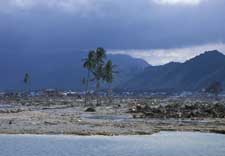
Devastated coastline in Aceh Province, Sumatra, Indonesia. Photo by Haroldo Castro
|
Initial reports stated that areas with intact natural ecosystems may have withstood the impact of the tsunami better than developed areas. The presence of healthy reefs, mangrove forests, sand dunes and other natural systems may also have saved lives and property in adjacent areas. There also are anecdotal reports that many animals survived by moving inland just before the tsunami hit. However, degradation, human settlement, and development may have compromised the ability of many coastal species and ecosystems to recover from the impact of the tsunami. The re-settlement of coastal communities in inland forests, and the extraction of timber and other resources for reconstruction and to meet immediate needs could gravely threaten vulnerable species and fragile ecosystems. The situation could be exacerbated due to the deaths of conservation professionals and the destruction of protected area infrastructure during the tsunami.
The tsunami itself caused significant damage to natural areas. Reefs have been damaged by debris, and sand deposited by the receding waters may result in further coral death. Along the coast, there has been damage to mangroves and other ecosystems, along with a great deal of beach erosion. The eggs of several species of threatened sea turtles, which nest on sandy beaches in much of the affected area, may have been washed away along with the sand. Further inland, salination of low-lying forests may cause a die-back of vegetation. Damage to these coastal ecosystems could place highly threatened species at risk, since a total of six hotspots were affected (Sundaland, Western Ghats and Sri Lanka, Indo-Burma, Madagascar and the Indian Ocean Islands, the Coastal forests of Eastern Africa, and the Horn of Africa). An analysis by BirdLife International shows that 27 globally threatened bird species are found in the areas of Asia affected by the tsunami. While many birds would have escaped the tsunami, threatened species such as the Nicobar megapode (Megapodius nicobariensis, VU), and nesting waterbirds such as the spot-billed pelican (Pelecanus philippensis, VU) may have been harmed.
Thus, the survival of threatened species could be jeopardized through direct mortality and habitat loss, through the loss of conservation infrastructure, and through increased pressure on remaining natural areas. The strongest hope for biodiversity in the affected regions will be well-planned restoration and reconstruction efforts, which incorporate coastal forest, reef and mangrove conservation and restoration.
| Birds and Conservation in Africa |
Top |
The Eleventh Pan-African Ornithological Congress (PAOC) was held in the heart of the Mediterranean Hotspot, in Djerba, Tunisia, 21-25 November 2004, and was hosted by the national Association "Les Amis des Oiseaux". The PAOC has established a very important role as a premier forum for the discussion of conservation issues in Africa, for birds and for biodiversity generally. The conference was attended by about 300 ornithologists and conservationists from nearly every African country. The conference's proceedings are in preparation for publication in Ostrich , the leading African ornithological journal. Support to the conference was provided by the Critical Ecosystem Partnership Fund , among others.
Conservation ornithology was a central theme of the congress, with several sessions devoted to the presentation of research in Important Bird Areas - those Key Biodiversity Areas of particular importance for bird conservation. Similarly, the conservation of African waterbirds, seabirds, and vultures - area-demanding birds that include a number of threatened species, received considerable attention. The presentation of cutting edge research using satellite transmitters to track such species was a highlight of the meeting. Much discussion also focused on the emergence of APLORI – the A.P. Leventis Ornithological Research Institute - a collaboration between the University of Jos (Nigeria), University of Lund (in Sweden), Universities of St Andrews and Edinburgh (Scotland), and the British Trust for Ornithology. APLORI has already led the education of number of Nigerian masters students on bird conservation themes, and seems poised to become an important regional training center.
Learn more about the Biodiversity Hotspots in Africa
| New Online Database of Species in the Hotspots |
Top |
 The hotspots species database is now available online! Search for terrestrial vertebrate species endemic to or occurring in the hotspots. The hotspots species database is now available online! Search for terrestrial vertebrate species endemic to or occurring in the hotspots.
The book Hotspots Revisited can be purchased directly from Conservation International. Visit CI's website to order your copy today. |
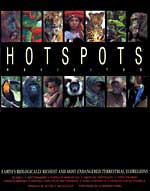
|





